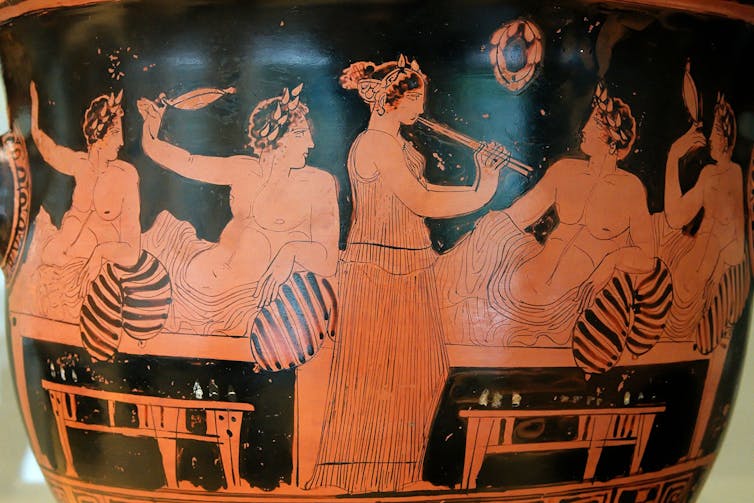One of the difficult things about working on the philosophy of love is that human relationships change, but our dominant images of love tend to remain the same.
The stability of these images reassures us that love is something deep, but we can also be trapped by them. The image of the soulmate has been around for a long time, yet our world has changed a great deal and so have our expectations of one another.
The terminology dates back to at least 1822 when it was used by the poet Samuel Taylor Coleridge. “In order not to be miserable,” he wrote, “you must have a Soul-mate.” However, the imagery Coleridge tried to capture is much older. It dates back to the Symposium – Plato’s dialogue written around 385BC.
What does the writing on the soulmate tell us?
Not all writing on the soulmate is positive – some warn of soulmates who drag us down rather than lifting us up.
As a cautionary tale, in the bowels of Dante’s Inferno (1320), lovers Paulo and Francesca are forever blown about by the winds of their own passion. They belong together, but the price of their misplaced love is eternal suffering.

Dante is telling us that the soulmates we desire might not be good for us, especially when sex gets in the way and the soul is distracted by the body.
Dante’s longing to be with his own soulmate, Beatrice, is shown differently. It is spiritually driven – he literally goes through hell to see her – but the meeting itself is a kind of judgment. There is no warm embrace.
Soulmate imagery of this sort offers a warning that we need to be fixed and a reassurance that there is someone who can fix us. We just need to keep looking.
Love in Plato’s Symposium
This is an idea that Plato had already considered and rejected. The Symposium describes a discussion of love that is disrupted by the hiccups of the playwright, Aristophanes.
Aristophanes claims that the gods were once jealous of our four arms and four legs, so they split us down the middle with a little adjustment towards the front. That slowed us down a bit. Now, whenever we meet our other half, we rush towards them and try to become whole again.

This is a lovely image, full of love’s intoxication and urgent bodily longings. But it places a heavy burden upon the other person. For example, it would lead me to expect my wife, Suzanne, to make me whole and her to expect the same of me. I am not sure that either of us would be cut out for such a demanding role.
Loving and being loved changes us, but it does not stop us from being human, with all that entails. There is a sense in which none of us is ever truly fixed.
What makes someone a soulmate?
The problem may not be with the idea of the soulmate, but with demanding too much from others.

While we live in a world where mortgages often last longer than marriages, the desire to share a life with someone is not going away any time soon. The need to think that relationships could last runs deep. And sometimes they do.
The problem with some of the classic soulmate imagery is not the idea of sharing a life, but the idea that doing so overcomes our incomplete nature, rather than modifying it.
What makes the other person a soulmate is that they love us as the incomplete and messed up beings that we are. Should we become more messed up than the average human, there are also perfectly good reasons why love should end.
This is a difficult idea to sell, particularly in the shadows of Plato, Dante and others who have built up our western imagery of love as something that draws us towards a goodness that will never end.
What this imagery obscures is the finite nature of love, how shared lives are shaped by an awareness that love ends when we end.
The beauty of finite love
Outside of western philosophy, love’s beauty is connected to its impermanence. For example, love is a central concept in works from the 20th-century Kyoto School of philosophy.
The texts of its founder, Nishida Kitaro, are haunted by a deep sense of love and irreparable loss. Kitaro claimed that love unites us not only with other humans, but also with other creatures, rocks and trees. Perishable beings and things that do not last forever. The pain of love’s end can also bring a kind of wisdom.

Saying this may seem disappointing, especially if we focus only on loving others, and forget the standpoint of those we love. I want my love for Suzanne to continue and not end. I want it to go on, forever. But I cannot help feeling that an eternity with me would not be a particularly good thing for Suzanne.
In fact, an eternity for any of us would be a little too much. Yet this is not disappointing. We have one life to live, and we choose to spend it with each other, for however long it lasts.
If we were to love in some endless and less fragile way then we really would end up like Paulo and Francesca – joined together forever, but not at all happy about our predicament.
Senior Researcher in the Philosophy of Ethics, Cosmological Visionaries Project, King’s College London